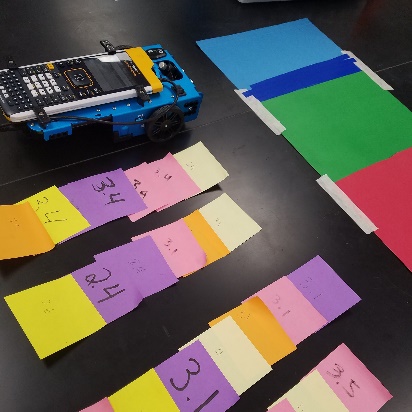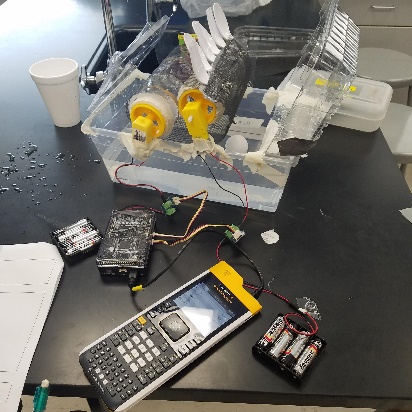Learning With Your Students
Teachers are supposed to know it all, right? When I first started teaching, I was terrified by the idea of a student asking me questions to which I did not know the answer. I would imagine myself freezing on the spot, turning beet red, and jabbering about something close to what they were looking for. I soon learned that this was a terrible idea, and saying, “I don’t know,” is an acceptable answer. What makes it more powerful for everyone involved is following it up with, “Let’s find out together!”
Taking the Plunge
This year, I took a major leap into the unknown by introducing coding into my biology classroom. I have never taken a coding class, and the only experience I had with coding was sitting in a few professional development workshops with the TI-Innovator™ Hub at previous T3™ International Conferences. I was hooked with the Smart Water system. In this STEM project, students write a program that collects data using several sensors and controls a water pump based on the conditions needed to sustainably water a garden. With this project, I finally saw the connection to my content area, and even more ideas began bubbling to the surface. I wanted to do more, so I wrote a grant through the Bright Minds Foundation, my district’s educational foundation, asking to purchase eight TI-Innovator™ Hubs, I/O kits, breadboard kits and STEM project supplies. When I got my acceptance letter, I was so excited — but very nervous — about following through with this grand idea of coding in biology class.
Starting Small
I made the goal to do at least one activity per quarter. I didn’t want to overwhelm the students, but I really wanted to make it sustainable for myself. We started off small and used the 10 Minutes of Code resources and the TI-Nspire™ CX graphing calculator to create a simple “Hello, World!” Then, we introduced the TI-Innovator™ Hub and made traffic lights, using different frequencies to make different sounds. The students thought it was fun, so we moved on to building a conductivity probe using resources from Path to STEM’s “How Clean is the Water?” We had been learning about watersheds and performing our own water quality analysis, and I thought that learning how the conductivity probe works would be a rich learning experience.

Throughout the year, we continued using resources available such as Science Through Engineering Design and Science in Motion using the TI-Innovator™ Rover. It was very helpful to have so many resources I could use to begin this journey, but the real test would come with my final project.

The Grand Finale
By the end of the year, students had a basic understanding of how to write simple programs using the TI-Nspire™ CX graphing calculator and TI-Innovator™ Hub. I thought they were ready for an original STEM project. They had to write their own programs to control DC motors and design a trash interceptor to remove single-use plastics out of waterways based on the concept of Mr. Trash Wheel. Since this was an original project, I could not directly fall back on the resources on the education.ti.com website. I had to help my students figure it out, and many of my answers to their questions were, “I don’t know; let’s find out!”

By taking the risk of doing something new, I was able to grow, personally and professionally, along with my students. Many educators may not feel comfortable with releasing the control, but it is so rewarding to see your students empowered by becoming the experts in the classroom.
Tagcloud
Archive
- 2025
- 2024
- 2023
- 2022
-
2021
- January (2)
- February (3)
- March (5)
-
April (7)
- Top Tips for Tackling the SAT® with the TI-84 Plus CE
- Monday Night Calculus With Steve Kokoska and Tom Dick
- Which TI Calculator for the SAT® and Why?
- Top Tips From a Math Teacher for Taking the Online AP® Exam
- Celebrate National Robotics Week With Supervised Teardowns
- How To Use the TI-84 Plus Family of Graphing Calculators To Succeed on the ACT®
- AP® Statistics: 6 Math Functions You Must Know for the TI-84 Plus
- May (1)
- June (3)
- July (2)
- August (5)
- September (2)
-
October (4)
- Transformation Graphing — the Families of Functions Modular Video Series to the Rescue!
- Top 3 Halloween-Themed Classroom Activities
- In Honor of National Chemistry Week, 5 “Organic” Ways to Incorporate TI Technology Into Chemistry Class
- 5 Spook-tacular Ways to Bring the Halloween “Spirits” Into Your Classroom
- November (4)
- December (1)
-
2020
- January (2)
- February (1)
- March (3)
- April (1)
- May (2)
- July (1)
- August (2)
- September (3)
-
October (7)
- Tips for Teachers in the time of COVID-19
- Top 10 Features of TI-84 Plus for Taking the ACT®
- TI Codes Contest Winners Revealed
- Best of Chemistry Activities for the Fall Semester
- Best of Biology Activities for the Fall Semester
- Best of Physics Activities for the Fall Semester
- Best of Middle Grades Science Activities
- November (1)
- December (2)
- 2019
-
2018
- January (1)
- February (5)
- March (4)
- April (5)
- May (4)
- June (4)
- July (4)
- August (4)
- September (5)
-
October (9)
- Art in Chemistry
- Which Texas Instruments (TI) Calculator for the ACT® and Why?
- Meet TI Teacher of the Month: Jessica Kohout
- Innovation in Biology
- Learning With Your Students
- A first-of-its-kind STEM strategy charts path to help educators
- #NCTMregionals Hartford 2018 Recap
- The Math Behind “Going Viral”
- Real-World Applications of Chemistry
-
November (8)
- Testing Tips: Using Calculators on Class Assessments
- Girls in STEM: A Personal Perspective
- 5 Teachers You Should Be Following on Instagram Right Now
- Meet TI Teacher of the Month: Katie England
- End-of-Marking Period Feedback Is a Two-Way Street
- #NCTMregionals Kansas City 2018 Recap
- Slope: It Shouldn’t Just Be a Formula
- Hit a high note exploring the math behind music
- December (5)
- 2017
- 2016
- 2015
